As a kid, I absolutely loved time-travel stories. I devoured Quantum Leap and Poul Anderson’s Time Patrol, and later in adulthood was very enamored with Connie Willis’s more sophisticated takes on the tropes. As cool science-fictional concepts go, time travel is pretty hard to top. By comparison every other genre of story is limited, bound to whatever milieu the author has chosen or invented. But time travel lets you go hopscotching through the universe — or a multiplicity of them — within the bounds of a single volume.
It also makes a pretty darn appealing premise for an adventure game, maybe even more so than for traditional fiction, what with setting being the literary element adventures do best. And indeed, time travel forms its own lively adventure sub-genre which just happens to include some of my very favorites. Time Zone does not make that list, but it is the first major text adventure to really explore the genre. Considering what a natural fit it is for an adventure game, I’m only surprised that a game like Time Zone took this long to appear. (And yes, I know I’m opening myself up to long lists of obscure or amateur titles that did time travel before Time Zone. By all means, post ’em if you got ’em. But as a professional adventure with a full-fledged time-hopping premise, I’d say Time Zone is probably worthy of recognition as the first text adventure to really go all in for time-travel fiction of the sort I knew as a kid.)
Time-travel stories may be written out of fascination with the intrinsic coolness of time travel itself, but they do often need some sort of framing premise and conflict to motivate their heroes. Time Zone goes with a B-movie riff on 2001: A Space Odyssey. It is the “dawn of man,” echoes the Time Zone manual, and mankind is being observed with interest by an advanced alien race, the Neburites. Here, however, the aliens are evil, and get pissed off as the centuries go by and mankind’s essential badassitude asserts itself:
The year is 4081. The Earth is a fast-paced, highly technological society. The advancement of Earth in the last 2000 years is an amazement to Earth historians and a constant source of pride to Earth scientists. The Neburites, though, feel quite the opposite.
In the 2000 years since our last glimpse of the extraterrestrials they have advanced little, and their jealousy for the Earth’s advancement has grown to a mad fervor. The evil Neburite ruler Ramadu fears that the Earth will very soon become the superior race in the galaxy. This must not happen. His plan is to strike now, before the Earth is advanced enough to defend itself against an attack. So Ramadu has built an awesome ray gun, and aimed it directly at the distant Earth.
It seems that unless something is done, if Ramadu is not stopped and his weapons destroyed, Earth will never see the year 4082.
Stopping him is, of course, a job for you, an everyday Earthling living in 1982, given to you along with a time machine by “a terrestrial guardian or keeper.”
It’s never explained just why you were chosen rather than someone from, you know, the year 4081 who might consider the Earth’s pending destruction a more urgent problem, nor why this mission needs to involve all this time travel at all. You must visit dozens of times and places to collect the equipment you’ll need to confront Ramadu on his home planet in 4081 — exotic stuff like a hammer, a knife, a rope, and a damn rock(!). It would be a lot easier and faster to pop into your house — the time machine just appeared in your back yard, after all — or at worst down the street to the local hardware store to collect these trinkets and be on your way directly to Ramadu.
To some extent these absurdities are part and parcel of adventure gaming even today. (If you somehow lose the walking stick that is key to many puzzles in my own game The King of Shreds and Patches, why can’t you just go to a shop and buy another one?) Even today games often drag and contort their stories, not without split seams and shrieks of pain, into shape to accommodate their technical affordances. As a collection of smaller adventures bound together with bailing wire and duct tape, Time Zone has no notion of global state other than through the objects the player is carrying with her, which she obtained by solving various zones, just as Wizardry has no way of controlling for winning other than by looking to see whether the party is carrying the amulet they could only obtain by taking out Werdna. The necessary suspension of disbelief just seems somehow more extreme in Time Zone, as, for example, when I park my time machine on a city street in the middle of downtown London without anyone seeming to notice or care.
But, yes, you can say I’m just anachronistically poking holes in a game running on very limited technology — except that Infocom released a game at the same time that showed that a reasonably consistent, believable premise and setting was very possible even with 1982 technology. (More on that in a future post.)
It’s not really surprising given the simplistic story and world model, but it is interesting to note the lack of many traditional time-travel tropes and concerns in Time Zone, the questions and paradoxes that do almost as much as the multiplicity of settings time travel offers to make it such a fun premise for a story (or a game). For instance, there’s no thought at all given to what happens if you change history. I suppose thought is not really needed, first of all because many zones have nothing interesting really going on anyway. For those that do, alteration of history is prevented by what Carl Muckenhoupt (whose own posts on Time Zone I highly recommend as companions to this one) calls “the poverty of the game engine.” The parser understands very little beyond what you have to do to solve the game, meaning that if you try to do something to mess with history — like, say, kill Christopher Columbus — you’re not going to be able to communicate your idea anyway.
The one place where Time Zone does nod toward traditional time-travel concerns is in not letting you carry objects back in time to a point before they were invented; if you try it, the anachronistic objects are destroyed. This of course provides Roberta Williams with a way of gating her puzzle design, preventing the player from using an obviously applicable item from solving this or that puzzle. It can also be very annoying, not only because it’s all too easy to be careless and lose track of what you’re carrying where, but also because it’s not always clear to the player — or, I strongly suspect given the countless historical gaffes in the game, to Roberta either — just when an item was invented, and thus just where the (time)line of demarcation really lies. In the small blessings department, the game does at least tell you when objects are destroyed this way. Given the era and the designer, one could easily imagine it keeping mum and letting you go quite a long way before figuring out you’ve made your game unwinnable.
But I should outline the general structure of the game before we go any further. From your home base that is literally your contemporary home, you can travel to each of the seven continents in any of five times — 50 BC, 1000 AD, 1400 AD, 1700 AD, 2082 AD — to collect what you need for the climax on Neburon in 4082 AD. (The manual says 4081, but it seems to have been written back when the game was still expected to ship in 1981 — thus the neat 2100-year gap.) Oh, and you can also visit 400 million BC, but only in one location. It’s explained as being thus limited because this was before the continents as we know them came into being. The same is also claimed to be true, bizarrely, of 10,000 BC (obviously there were no geologists around On-Line). Not all of the zones need to be visited; some serve only as red herrings. In what is, depending on your point of view, either a ripoff or the funniest joke in the game (or both), Antarctica in every single time consists of just a single location. You can only get out of your time machine, say, “Gee, it’s too cold here,” and climb back inside.
Some of the zones contain historical characters drawn straight from grade-school history books, giving the game (like so much of Roberta Williams’s work) a feel of children’s literature.
If you’ve been paying attention, you’ll note that Time Zone is not exactly rigorous about putting these characters precisely when they belong. It’s kind of tough to know to what extent Roberta messes with chronology just to be able to fit in all the cool stuff she wants to given just five time periods in which to put it all — Columbus certainly seems like a must-have, even if he is displaced by 92 years — and to what extent it’s all down to sloppy or nonexistent research. In her interview with Computer Gaming World to promote Time Zone, Roberta mentions an error she made, placing a rhea bird in Australia rather than South America. She explains the error away more disingenuously (or is this supposed to be funny?) in the manual:
To make a more interesting and challenging adventure, we have made some minor changes. For example, at one point in the game (I won’t say where) we have placed a rhea egg where you will never find a rhea bird. Anyone knowledgeable in ornithology knows that a rhea bird belong in South America (which is not where it is). This type of thing happens from time to time in Time Zone.
Worrying so much over such a minor point leaves one thinking that Time Zone‘s history must be rigorous indeed. Um, no. In addition to thinking that Pangaea still existed in 10,000 BC, the game also thinks that man invented fire in 10,000 BC. (In fact, it lets you be the one who invents fire, creating all sorts of timeline repercussions — if the game was more interested in such things, that is).
And it places brontosauruses (from the Jurassic period) and tyrannosauruses (from the Cretaceous) together in 400 million BC, hundreds of millennia too early for either. And then there’s Napoleon ruling in 1700 AD.
It’s hard for me to attribute this to the need to have cool stuff, because Louis XIV’s France was a pretty interesting historical moment in its own right. And your mission in this zone is to collect a comb and some perfume, which fits better with the Sun King’s effete court than with the more martial Napoleon. So, I must reluctantly conclude that Roberta doesn’t know her Louis XIV from her Napoleon. She also thinks that Saint Petersburg is in Asia, and that Peter the Great was the husband of Catherine the Great. “History books aren’t a lot of fun,” she asserts in the manual. Which kind of begs one to wonder why someone who doesn’t like history books is writing a game about history.
Time Zone has always had a reputation as a fearsomely unfair and difficult game. That’s true enough, but it’s not universally true when you look at it in a granular way. Many — probably most — of the puzzles break down into a few repeated archetypes, such as trading one fairly obvious item for another item.
There’s even a limited but surprising amount of kindness (or “user friendliness,” as the manual says over and over; presumably that term had just come into vogue). In addition to the game’s being kind enough to tell you when you lose an item in the timestream, the inventory limit, while present, is a very generous 16 items or so. And there is only one maze, if we restrict the term to rooms that are not laid out so that going north after going south gets you back where you started.
There are, however, large, tedious-to-map grids of empty rooms in virtually every zone you visit, and the game never tells you which exits from a location are available, forcing you to rely on trial and error. (Thank God the Hi-Res engine doesn’t support diagonal exits.) Indeed, Time Zone may have the shabbiest ratio of rooms to things to actually do in them in adventure-game history. By my count there are 57 items in the game, about the same as each of the first two Zork games — but spread over more than 1300 rooms. If anything the ratio feels even worse than that, as you wander through endless “pastures,” “meadows,” “fields,” and “city streets.” Actually playing Time Zone feels not like a grand journey through history, but rather a long slog through a whole bunch of nothing. No wonder poor Terry Pierce was reduced to tears at having to draw this monotony.
To relieve the boredom, entering some of these otherwise meaningless locations leads to instant death. The only way to solve many of these “puzzles” is to learn from the deaths and not enter that location again.
Some of the pictures are pretty nice, up to the standard of the earlier Hi-Res Adventures. Others show the strain of drawing 1400 pictures in eight months; they look pretty bad.
Something that’s often overlooked about the Hi-Res Adventures today is that they are not simply text adventures with illustrations, after the style of, say, the Magnetic Scrolls games of the later 1980s. Right from Mystery House there was an element of interactivity to their graphics: drop an item in an area and you would see it there; open a door and you would see it open onscreen; etc. That’s quite impressive. However, occasionally, just occasionally, Roberta decides to put essential information into the picture rather than bothering to describe it in text. Because this happens relatively seldom, and because there’s so much else in those pictures that isn’t implemented in the game, these occasions are devilishly easy to miss entirely.
In the picture below, that little green thing at the bottom right that looks like an air vent is an essential oxygen mask — apparently for a person with a very weirdly shaped head, but that’s another issue — that’s going to get destroyed if we go back in time with it in the time machine with us.
Nothing in the picture below is implemented except one of the drawers, which contains a knife that you need.
Only the cabinet is implemented below, which… you know the drill.
And the tusks of the elephant skeleton are implemented as separate objects that can be pried out and taken, something I’d never suspect in a million years.
All of this is frustrating in the extreme, but none of it is really that different from the other Hi-Res Adventures. What makes Time Zone so untenable, and leads to its reputation for difficulty and cruelty, is the combinatorial-explosion factor. There’s a pretty fixed order in which you need to work your way through the zones, using items found in one to solve puzzles in the next. Yet the game gives no clue whatsoever what that order must be, leaving you hopelessly at sea about where to go next or what to work on. (And then of course if you miss something like one of the above…) By late in the game you’ll have a full inventory plus a whole collection of extra objects piled outside your time machine, and won’t even know what to take with you from zone to zone.
Throw in all of the other annoyances — the pointless sudden deaths; the huge empty maps; the items and entire zones that serve only as red herrings; the uncertainty about what you can and can’t interact with; the obstinate parser; and just a few howlingly bad puzzles to top it all off — and the result is just excruciating. Theoretically this game could be solved, but really, why would you want to? Anyone willing to put this amount of methodical, tedious work in for so little positive feedback might be better off doing something that benefits mankind, or at least earns her a paycheck.
Or maybe it can’t be solved. It wouldn’t be a Roberta Williams game without a couple of really terrible puzzles. One of those is found in Asia (should be Europe, but why quibble?) in 1700 AD, where you have to wait outside Catherine the Great’s castle for five turns for no apparent reason for her to emerge with hubby Peter the Great and drop a hat pin.
This is made especially annoying by the fact that the game doesn’t even have a WAIT verb; you have to fiddle around with endless LOOKs and the like to get the turns to pass. (If you construed from the lack of WAIT that there would be no puzzle mechanics involving time, the joke’s on you.)
The other crowning jewel is the mountainside in the Asia of 1000 AD where you must type a totally unmotivated OPEN SESAME.
Puzzles aside, Time Zone just feels a bit amateurish and sloppy most of the time. Like a piece of fiction from a beginning writer, one senses that no one is in control of its tone or message, which veer about wildly. Nowhere is this more painful than in its depictions of the non-white natives of the zones, which come off as hilariously racist — but, I’m sure, unintentionally so.
There are also weird occasions when the “children’s book” tone suddenly gives way to thoughtless violence.
So, no, Time Zone is not a very good game. The climax on Neburon, which takes two disk sides by itself, is actually the strongest part, full of sudden deaths and empty rooms but also possessed of a forward narrative drive and sense of tension that was still rare in this era, as you penetrate deeper and deeper into the alien base. If released on its own, it would have stood up as possibly the best of the Hi-Res line. As it is, though, it comes at the end of such an exhausting slog that it’s hard to really appreciate. By the time you see the victory screen — which, incidentally, makes no sense; why are the people in your home town of 1982 celebrating a victory you won in 4082? — you’re just glad it’s over, just like the team who made it were when they finally got it out the door.
Sometimes, as The Prisoner taught us, the best way to win is not to play. Time Zone is perhaps doubly disappointing because the premise has so much potential. But neither the technology nor the designer were really equipped to realize such an ambitious idea, and certainly not in the time allowed. Still, Time Zone is of undeniable historical significance, so I have the Apple II disk images and the manual for those of you who’d like to dive in.
Next time: a bit about the aftermath of Time Zone before we move on to something else.
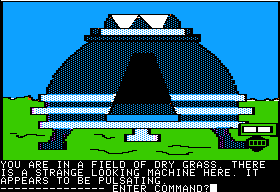
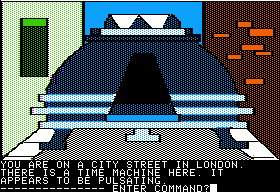
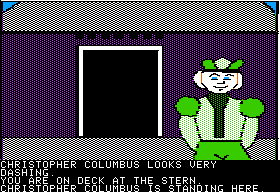
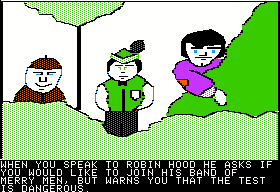
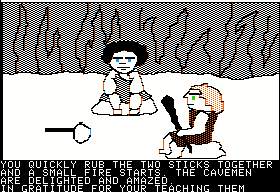
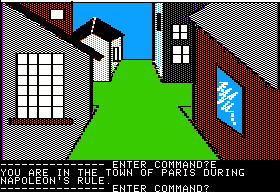
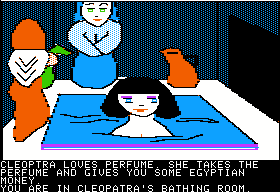
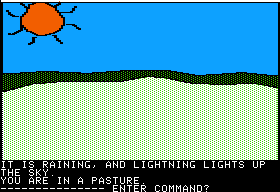
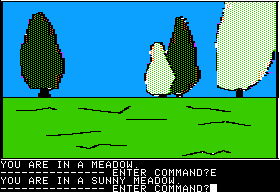
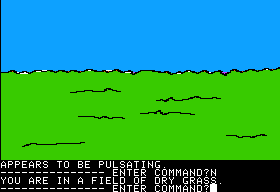
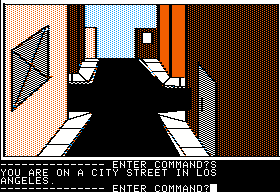
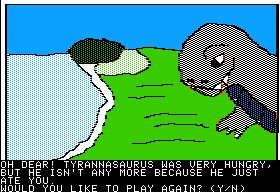
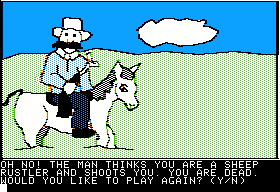
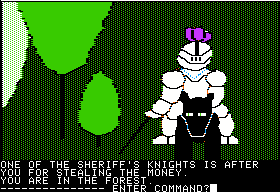
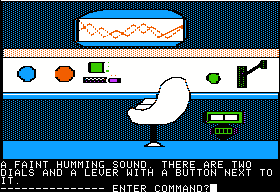
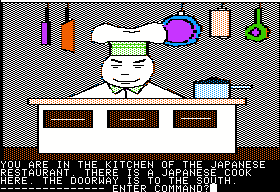
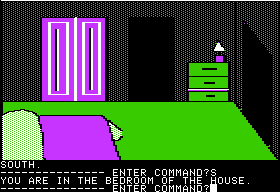
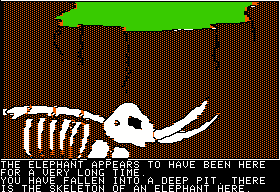
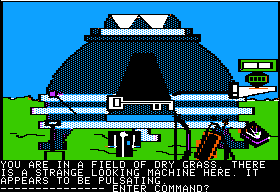
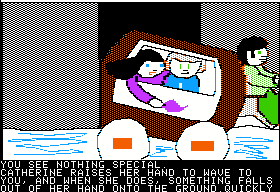
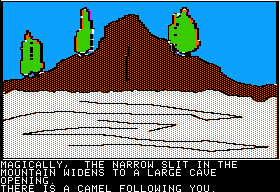
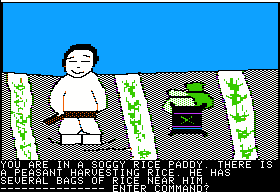
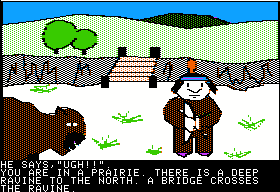
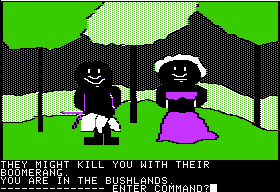
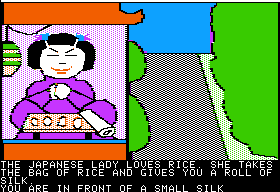
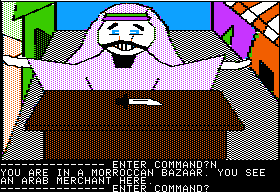
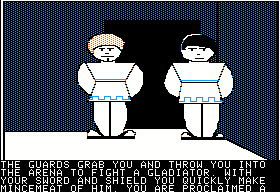
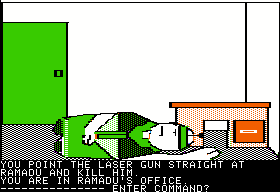
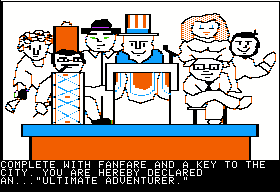









Sam Kabo Ashwell
June 8, 2012 at 12:15 am
Awesome post, as ever; thank you.
Minor niggle: in what sense is Baghdad *not* in Asia? I know that Americans have a habit of using “Asian” to mean “from places where they have epicanthic folds”, but the classical definition is that Asia and Europe are divided by a line running more or less through the Bosphorus, Black Sea, Caucasus and Urals.
Jimmy Maher
June 8, 2012 at 6:42 am
Woops… that was supposed to read Saint Petersburg, not Baghdad. (How the hell did that happen?)
Thanks!
DZ-Jay
February 12, 2017 at 12:28 pm
Well, in her defense, Roberta probably thought: “St. Petersburg is in Russia, and Russia is in Asia.” Not much of a defense, I know, but I guess it’s an understandable error from the typical geography-challenged American. ;)
-dZ.
AK
June 8, 2012 at 7:39 am
I have to agree with Sam; in what continent is Baghdad in if not in Asia ?
Jake
June 8, 2012 at 5:08 am
Time Zone may have the shabbiest ratio of rooms to things to actually do in them in adventure-game history.
That depends how you count Snowball, I suppose.
Also, that Moroccan merchant’s moustache and teeth are going to haunt my nightmares now.
Felix Pleșoianu
June 8, 2012 at 8:14 am
For the same reason there were fireworks on Coruscant hours after Death Star II exploded. :P
That happens in Ekphrasis at one point: a phone number is only visible in the picture area, so if you play the game in text mode you’re hosed. At least it’s obvious what’s going on.
In all honesty, while history is fascinating, history textbook are dreadfully dreary. I don’t suppose the History Channel existed back then? Not that I’m trying to find excuses for obvious howlers.
I’m fairly certain that qualifies as a genre in-joke, either via Dr. Who or Douglas Adams. And it’s not like modern adventures don’t do that sort of thing. Willing suspension of disbelief and all that.
Last but not least, I grew up with Time Patrol myself, and it was awesome. But after reading The Dancers at the End of Time last year, I wouldn’t go back.
J.P. McDevitt
February 22, 2013 at 5:52 am
Wow…this is the first time I’ve read about a game where I got the sense that the game was truly horrifyingly unfair. Certainly there are other games with bad and random puzzles, but as far as I know none of them have 1300-1500 rooms.
namekuseijin
February 13, 2014 at 10:35 pm
I look at these absurdly crude pictures of amateur child sketching and wonder about people who have fond memories of such horrors. Ok, it was novel back then, but even in face of novelty, they still look horrid.
It also seems they sacrificed good prose in order to get picture space and then ended up having no good prose and no good pictures. It’s one hell of a mix of Scott Adams text-adventures and Pong stick graphics.
In the end, it reads and looks like kindergarden grade material and plays like a sociopath twine BDSM hypertext.
It’d make me glad we’re not in the early 80’s anymore, except that a 70’s game reads and plays much better than that crap, along with its legitimate descendants.
DaveK
August 3, 2015 at 4:39 am
Sometimes, as The Prisoner taught us, the best way to win is not to play
Sure you didn’t mean WarGames?
Jimmy Maher
August 3, 2015 at 7:23 am
No, I meant The Prisoner. While War Games would fit as well, I actually wrote this article shortly after writing about The Prisoner: http://www.filfre.net/2011/11/the-prisoner-part-1.
Steve
March 29, 2017 at 4:17 am
The lead-in article talks about how stressed the artist was trying to get 1400 pictures drawn in eight months; yet actually seeing the final graphics, I’m left wondering how it was such an issue…
Was his artwork more detailed and realistic than the finished product implies? If so, imagine his shock at seeing the effort he put in wasted, the final drawings literally looking like something found on a new parent’s fridge.
I can’t imagine how producing 6 such drawings per day was in any way a problem… After all, he was just sketching, correct? He didn’t even have to implement the things!
Todd B.
August 16, 2017 at 4:13 am
You don’t get a ribbon in Wizardry for taking out Werdna… You get it on the 4th level when you accept the quest to take him out, and then use it for the elevator that gives you access to the lower floors where he is.
Todd B.
August 16, 2017 at 4:15 am
Forgot to add that I think you obviously meant to say “amulet” not “ribbon”. Love this blog, by the way. One of the best there is.
Jimmy Maher
August 16, 2017 at 12:08 pm
Thanks!
StevenK
February 7, 2018 at 7:09 am
In the very early ’80’s my dad bought an Apple II+, and allowed me to pick out a game at the game store. Wizardry called to me, and absolutely blew my mind – and most of my early-teen summer, as well as that of a couple of my friends. We stayed up ’til dawn on so many evenings mapping and playing. I don’t think we’ve every forgotten that. We spent the next few years of high school swapping pirated games and exploring the wonders of creativity coming out of early game-programming minds….
Then at some point I remember seeing that poster or cover-art for Time Zone. I knew this had to be the most amazing experience ever created. It must have impressed my dad as well because he forked-out the $100 to buy it. I barely remember anything about the game, it was just simply a total let-down in playability & game-mechanics. I remember trying to hide the box below some computer magazines hoping somehow my dad would just forget how badly I’d wanted it. I felt shame at having been fooled.
I’ve occasionally thought of this game over time, but never even remembered the name of it. It’s been a bitter-sweet pleasure to re-connect with this little-remembered, icarian-flight of over-priced teenage trauma!
David Chou
February 1, 2019 at 5:18 pm
So there was no Atari-ET-Sierra-Escape-from-Mt-Drash burial for unsold copies??
As in, all copies were sold?!?!
Will Moczarski
February 16, 2020 at 10:33 am
except that Infocom released a game at the same time that showed a reasonably consistent, believable premise and setting was very possible even with 1982 technology.
This is either a bit convoluted or might need another word (setting that was/which was…)
Will Moczarski
February 16, 2020 at 12:18 pm
And here there should be an additional “it”:
when you look at in a granular way
Jimmy Maher
February 17, 2020 at 4:56 pm
Thanks!
Ivan X
June 27, 2020 at 7:34 pm
Just finished Time Zone, after on and off trying for 38 years, and hacking the game to support 14 drives (which the Virtual ][ emulator supports) so I didn’t lose my mind swapping disks. I can’t disagree with any of your review, except I had a different emotional reaction to it: for all of its flaws, I loved it.
But that may have been as much due to my lifelong desire to beat it, since I was 12, and a predisposition to like On-Line’s games because I was introduced to the adventure game genre via Mission: Asteroid and Wizard and the Princess. And so yes, there was severe mapmaking tediousness, but there’s some virtuous feeling I now have in having finally documented and mastered all the boundaries and contours of this gigantic, overwhelming world.
As for the nonobviousness of the sequence of zones, I just treated them as regions of a single map, with the time machine as central junction, rather than as islands. You can’t really know when you’re done with one of them, and you do need objects from one to solve puzzles in another, so they’re not really self-contained. Thinking about them this way made the game make more sense, especially the empty zones — it’s just like just a really, really, really, really, really big version of Wizard and the Princess, that requires a little bit of object management to keep things from disappearing if you’re not careful.
As for the general failing of real-world reasoning, I just had to keep reminding myself that it’s a game, not a simulation, and I’m just playing within the bounds of what it allows, like any arcade game. That certainly diminishes the immersive “you are there” feeling that the better Infocom titles offer, but once I embraced Time Zone’s world, I was fully able to enjoy the game on its own silly terms, working within its own silly logic.
The game required extreme organization, beyond anything I’d played before, not only with the mapping but also keeping track of objects and the various spots in which I was simultaneously stuck. (The closest I’ve encountered before was the original MIT Zork, which I played before Zork II and III. It’s pretty huge.) But eventually I was able to work everything out, so it evidently wasn’t impossible, as I’d feared. I suppose being able to summons the will and ability to organize and execute, and ultimately prevail, after having failed to do so in multple attempts over decades, was its own reward, even if all I’d done was triumph over a particularly mean game that is difficult for a lot of the wrong (but some of the right) reasons. Persistence paid off.
And my admiration for the effort and ambition involved in the game’s creation (there are *so many hand-drawn screens), even where it was unsuccessful or misguided or unenlightened, never really abated as I played the game, and kept me enjoying it even when it was a slog.
Small correction to the review: what you find in the kitchen of the Japanese restaurant is matches, not a knife.
Also, an odd observation, which I might never have found if not for your review: The mountain in 1000AD Asia never actually has to be opened to get the gold, which means you don’t need the camel, which means you don’t need the rug, which means you don’t need the silk, which means you don’t need the rice, which means you don’t need the second piece of jade. That sequence of puzzles, as well as the one involving the rhea egg (which you can fill with water in 2082AD Africa by making a hole with the hat pin and emptying it) turn out to be totally optional, which I only discovered because I solved the game without them — and clearly within the game’s design, not via a bug.
The problems those items ultimately address — the water-filled egg for dehydration in 1400AD Asia, and the gold to prevent being wounded by the thief on Neburon — turn out to not be necessary to still finish the game, and since no score is kept, there’s no urgency or even indication that these could alternatively be solved the “right” way. (And a much more minor version of an optional puzzle is the lion in 1000AD Africa, which can be driven away with the right items, but also just avoided, like so many of the other superfluous killer animals and humans in the game.)
The fact that you can expend effort on so much unnecessary work — its own form of red herring — does lead me to believe that the game designers conflated difficulty with cruelty, or that they just didn’t have time to think it all through and get it completely right before they released it. (And I guess I wonder whether I would have *ever* come up with “open sesame” if I’d had to, as that really is the single least logical part of the game — nowhere else is magic invoked. It will remain a mystery.)
Looking at the disks, I didn’t find any further “optional” puzzles, nor did I find any solutions to any of the puzzles that I wrote off as not solveable.
Thanks for the review, and the surrounding articles with insight and history!
Jason Dyer
February 28, 2022 at 5:46 pm
I only just now read this thread, but I quoted your tweet about finishing the game in my playthrough of Time Zone.
https://bluerenga.blog/tag/time-zone/?order=ASC
Thanks for that, it gave me a little confidence it was possible.
Jeff Nyman
September 19, 2021 at 2:03 pm
But, yes, you can say I’m just anachronistically poking holes in a game running on very limited technology — except that Infocom released a game at the same time that showed that a reasonably consistent, believable premise …
Exactly. Limited technology does not mean you have to come up with an incoherent plot or setting or how actions taken place within the context of both. Too much is forgiven of older games by suggesting that somehow it was the “limited technology” when, in fact, it was really just bad game design.
So I think that “poverty of the game engine” idea is misplaced and makes the following comment very odd:
The parser understands very little beyond what you have to do to solve the game, meaning that if you try to do something to mess with history — like, say, kill Christopher Columbus — you’re not going to be able to communicate your idea anyway.
So the parser wouldn’t have been able to understand a command like “kill columbus”? Of course it would have. What there wasn’t in place was a world model that would accommodate to that change. But, then again, there didn’t need to be because the design of the game was not focused on what you could or couldn’t do in terms of changing history. Certainly the game could have had a design like this:
(1) If player kills Columbus, when they go to location X then item Y is not shown.
(2) If the player does not kill Columbus, when they go to location X then item Y is shown.
That has nothing to do with the parser at all. It’s just not what the game was designed to be. In this case, there was nothing about Columbus’ impact on history as part of the game and thus nothing would be relevant about killing him. (Granted, an attempt to do so could be handled by something like: “But then you would change history!”) Contrast that with:
(In fact, it lets you be the one who invents fire, creating all sorts of timeline repercussions — if the game was more interested in such things, that is).
Here there could have been the route of you don’t change the past, you fulfill it. So in that context it was always you and your interventions in history that led to the creation of fire. But, as you say, the game isn’t designed around time travel except as a mechanic, not a plot device.
Which kind of begs one to wonder why someone who doesn’t like history books is writing a game about history.
Exactly! No technical limitations have to be presumed here. Rather, we can just say this was an extremely poor game design.
Jeff Nyman
September 19, 2021 at 2:06 pm
Time Zone just feels a bit amateurish and sloppy most of the time.
Agreed. And historically that’s probably the more interesting point here. It would be interesting to consider the designs of, say, the other Hi-Res games (or even the Scott Adams games, whatever) and ask if there’s some corollary not just to the ambition but to the amount of people working on that ambition.
It should be interesting that a game that had many more people, of diverse skill sets, working on it ended up being, arguably, one of the worst of the lot. Any one who has worked in any sort of software development at all knows the dangers of the cumulative effect of “many people, one project.”
This was clearly a case of wanting to build an absolutely huge game and then coming up with a mechanic (“time travel to various eras and visit various continents!”) that would satisfy that desire. This is as opposed to having an interesting idea and seeing what kind of game design could be created around it. It might be interesting to consider Legend Entertainment’s game TimeQuest in relation to this one.
Time Zone is perhaps doubly disappointing because the premise has so much potential. But neither the technology nor the designer were really equipped to realize such an ambitious idea.
Yes, I agree entirely and I think this reinforces my point above. The premise wasn’t the point; it was just the window dressing around the actual conceit: the desire to create a very large, perhaps the largest ever, adventure game.
I think blaming the technology is a common thing but this premise could have been carried out in an interesting way even with the technology at the time. It simply wasn’t done that way in this case. So the focus is really on the design and how that design was not consistent with the premise because, ultimately, the premise just wasn’t the point.
Since I know some of this blog is concerned with the idea of ludic narrative, it feels like that is probably the most interesting aspect of Time Zone in that context.
Jason Dyer
February 28, 2022 at 5:44 pm
Finally got to read this post, 10 years after the fact!
>And there are technically no mazes, if we restrict the term to rooms that are not laid out so that going north after going south gets you back where you started.
There is the (totally not useful) maze in Australia which does this. A few other spots kind of do this but I think they’re literal bugs as opposed to intentional loops.
As Ivan pointed out, the gold from OPEN SESAME turns out to be totally optional, and it really is designed in — the hospital scene from the future is entirely based on getting shot by the thief, and there’s a multi-room location dedicated to it. I really would like to know the logic there, but that does take out what I’d argue is the second-worst puzzle (I did solve it extremely quickly, but I’ve played enough Roberta Williams now to suspect what she was after).
The first-worst is probably the hat pin dropping. It’s not an “easy or hard” puzzle, it’s “did you spend enough time noodling in the right room”. If you miss it, there’s not really a reason to know (as far as I can tell you can’t “miss” the scene entirely though — the time “advances” only if you’re in the room in question).
The third-worst, probably the tusks. If it wasn’t in a puzzle-within-a-puzzle I wouldn’t have had a chance, but there was so much invested in getting to that spot of the map I figured there _had_ to be something.
Jimmy Maher
March 4, 2022 at 9:00 am
Congratulation on your achievement! Small edit made on the subject of mazes… ;)
GusCE6
August 28, 2023 at 8:23 pm
No, there is no racism here. Not at all.
What I see here was typical of ultra-ambitious projects.
This was decades ago, with what now is seen as hopelessly primitive technology. But in its day this was one of the largest games a typical computer gamer could buy; if memory serves it was on SIX double-sided discs.
But now you have to consider that the programmers had to deal with more primitive technology, insane schedules created by people who had no idea what went into these games, and of course budgets. I can guarantee many, if not most, of those images were rushed out.
I wonder of the failure of “Fallout 76” was due to similar factors…in this case modern technology demanding more, even.
Vince
December 16, 2023 at 8:55 pm
“Anyone willing to put this amount of methodical, tedious work in for so little positive feedback might be better off doing something that benefits mankind, or at least earns her a paycheck.”
Oh well, I just finished it, over the course of a few months (very on and off, but still probably totaling over 100 hours) mapping everything in Trizbort (here a very zoomed out view of the result https://ibb.co/gzkQCzv ). No hints were necessary, although I missed the “optional” puzzles that Ivan X describes above.
Ivan’s comment describes my experience with the game pretty well. It really requires the player to be organized and keep extensive notes, but none of the puzzles is THAT bad. In the worst case, most can be solved by typing “USE [item]”, which is not an example of sterling game design, but it makes brute forcing a possibility.
The real difficulty is really the insane amount of red herrings, which you really don’t know if they are such or actual puzzles. Counting Antartica as one, to my math there are 10 locations that are red herrings, including the worst maze in the game and a lot of obstacles that LOOK like puzzles to solve (the polar bear in Alaska, the dam guard in Egypt, the gorge in the Andes…).
As the post says Neburon is by far the best part. but you really don’t know in advance what items you need, so it is also kind of a frustrating experience. I cannot imagine how excruciating must have been realizing you needed an item you left home and having to redo Neburon all over again with the load times and disk swapping of an actual Apple II.
As per my motivation to play it, well, that would be the challenge. Completing legitimately such a complex and notoriously difficult game provides (to me) warm and fuzzy feelings that more modern games that benefit from 40+ years of game design insight often failed to elicit (I can safely state I enjoyed playing Time Zone more than Starfield).